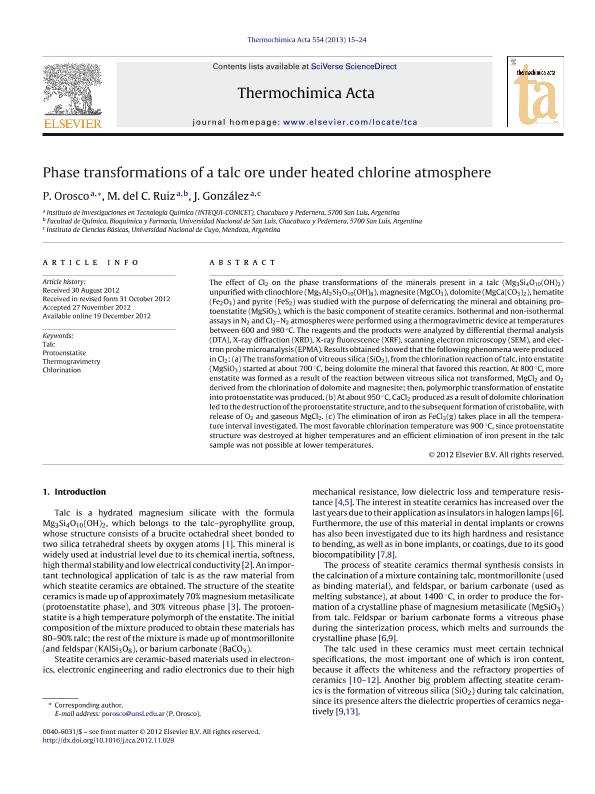Mostrar el registro sencillo del ítem
dc.contributor.author
Orosco, Roberto Pablo

dc.contributor.author
Ruiz Salado, Maria del Carmen

dc.contributor.author
Gonzalez, Jorge Alberto

dc.date.available
2015-09-30T15:47:48Z
dc.date.issued
2013-02-20
dc.identifier.citation
Orosco, Roberto Pablo; Ruiz Salado, Maria del Carmen; Gonzalez, Jorge Alberto; Phase transformations of a talc ore under heated chlorine atmosphere; Elsevier Science; Thermochimica Acta; 554; 20-2-2013; 15-24
dc.identifier.issn
0040-6031
dc.identifier.uri
http://hdl.handle.net/11336/2207
dc.description.abstract
The effect of Cl2 on the phase transformations of the minerals present in a talc (Mg3Si4O10(OH)2) unpurified with clinochlore (Mg5Al2Si3O10(OH)8), magnesite (MgCO3), dolomite (MgCa(CO3)2), hematite (Fe2O3) and pyrite (FeS2) was studied with the purpose of deferricating the mineral and obtaining protoenstatite (MgSiO3), which is the basic component of steatite ceramics. Isothermal and non-isothermal assays in N2 and Cl2–N2 atmospheres were performed using a thermogravimetric device at temperatures between 600 and 980 °C. The reagents and the products were analyzed by differential thermal analysis (DTA), X-ray diffraction (XRD), X-ray fluorescence (XRF), scanning electron microscopy (SEM), and electron probe microanalysis (EPMA). Results obtained showed that the following phenomena were produced in Cl2: (a) The transformation of vitreous silica (SiO2), from the chlorination reaction of talc, into enstatite (MgSiO3) started at about 700 °C, being dolomite the mineral that favored this reaction. At 800 °C, more enstatite was formed as a result of the reaction between vitreous silica not transformed, MgCl2 and O2 derived from the chlorination of dolomite and magnesite; then, polymorphic transformation of enstatite into protoenstatite was produced. (b) At about 950 °C, CaCl2 produced as a result of dolomite chlorination led to the destruction of the protoenstatite structure, and to the subsequent formation of cristobalite, with release of O2 and gaseous MgCl2. (c) The elimination of iron as FeCl3(g) takes place in all the temperature interval investigated. The most favorable chlorination temperature was 900 °C, since protoenstatite structure was destroyed at higher temperatures and an efficient elimination of iron present in the talc sample was not possible at lower temperatures.
dc.format
application/pdf
dc.language.iso
eng
dc.publisher
Elsevier Science

dc.rights
info:eu-repo/semantics/openAccess
dc.rights.uri
https://creativecommons.org/licenses/by-nc-nd/2.5/ar/
dc.subject
CHLORINATION
dc.subject
PROTOENSTATITE
dc.subject
TALC
dc.subject
THERMOGRAVIMETRY
dc.subject.classification
Ingeniería Química

dc.subject.classification
Ingeniería Química

dc.subject.classification
INGENIERÍAS Y TECNOLOGÍAS

dc.title
Phase transformations of a talc ore under heated chlorine atmosphere
dc.type
info:eu-repo/semantics/article
dc.type
info:ar-repo/semantics/artículo
dc.type
info:eu-repo/semantics/publishedVersion
dc.date.updated
2016-03-30 10:35:44.97925-03
dc.journal.volume
554
dc.journal.pagination
15-24
dc.journal.pais
Países Bajos

dc.journal.ciudad
Amsterdam
dc.description.fil
Fil: Orosco, Roberto Pablo. Consejo Nacional de Investigaciones Científicas y Técnicas. Centro Científico Tecnológico San Luis. Instituto de Investigaciones en Tecnología Química; Argentina
dc.description.fil
Fil: Ruiz Salado, Maria del Carmen. Consejo Nacional de Investigaciones Científicas y Técnicas. Centro Científico Tecnológico San Luis. Instituto de Investigaciones en Tecnología Química; Argentina. Universidad Nacional de San Luis. Facultad de Química, Bioquímica y Farmacia; Argentina
dc.description.fil
Fil: Gonzalez, Jorge Alberto. Consejo Nacional de Investigaciones Científicas y Técnicas. Centro Científico Tecnológico San Luis. Instituto de Investigaciones en Tecnología Química; Argentina. Universidad Nacional de Cuyo; Argentina
dc.journal.title
Thermochimica Acta

dc.relation.alternativeid
info:eu-repo/semantics/altIdentifier/url/http://www.sciencedirect.com/science/article/pii/S0040603112005631
dc.relation.alternativeid
info:eu-repo/semantics/altIdentifier/doi/http://dx.doi.org/10.1016/j.tca.2012.11.029
Archivos asociados
